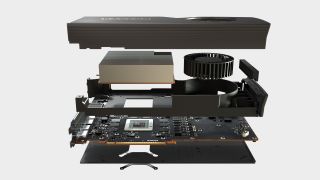AMD's best Big Navi GPU may only be a match for Nvidia Ampere's second tier
The latest performance rumours suggest AIBs are more reserved about RDNA 2's relative performance against Nvidia.

The flagship AMD Big Navi RDNA 2 graphics card is reportedly set to deliver performance on par with the RTX 2080 Ti, and to be launched as a direct competitor to the Nvidia Ampere-based GeForce RTX 3080. That's potentially significant because it means AMD is not expecting to take on the top-end RTX 3080 Ti from Nvidia when it launches its own enthusiast-class GPUs.
This comes from a report by Coreteks, which suggests AMD has been sharing fresh details about the next generation of Radeon cards with its add-in board partners (AIBs). It claims the top RDNA 2 GPU, fishily codenamed Sienna Cichlid, will bat around the same level as the RTX 2080 Ti, though in best-case scenarios it could beat it by as much as 15% in terms of gaming performance.
As ever such a 'best-case' will be in the select few games which have specific AMD optimisations, and traditionally offer higher frame rates against comparative GeForce GPUs.
This level of performance is expected to pit the top Big Navi card against the RTX 3080, with the AMD Radeon card likely to be priced to undercut the second-tier Nvidia Ampere GPU as it will be launched later. And we all know how much AMD loves a price war...
There have been many performance rumours leading up to this year's launch of AMD's Big Navi cards, some conflicting, and none of them that we can actually point to and say 'this is definitely correct.' We are getting closer, and if this really is coming from the AIBs then there it feels like it has a bit more of an of authority.
But still, it's anonymous and therefore has to be treated with as much skepticism as everything else that's surfaced about the next-gen Radeon GPUs. Right now, the performance rumours range from Big Navi destroying the top Ampere card to only taking on its second-tier offering.
This latest report, however, claims that there will be a reveal event in early September for the new AMD RDNA 2 cards, with a release date on October 7. With the Nvidia Ampere release date rumoured to be September 17, and sampling suggested to occur late August, I wouldn't be surprised to see AMD aiming to spoil the launch with its own reveal just ahead of it.
The biggest gaming news, reviews and hardware deals
Keep up to date with the most important stories and the best deals, as picked by the PC Gamer team.
We may even see AMD releasing some speculative pricing ahead of the Ampere launch, which are then miraculously lower by the time Big Navi launches. The 'jebait' situation around the RX 5700 XT launch was all kinds of weird, but I don't doubt something like that could happen again, especially with such a closely timed launch period.


Best CPU for gaming: the top chips from Intel and AMD
Best graphics card: your perfect pixel-pusher awaits
Best SSD for gaming: get into the game ahead of the rest
Coreteks' AIB sources also suggest there will be a pair of Big Navi GPUs at launch, based on the same Sienna Cichlid silicon. That's not much of a stretch as this is classic AMD graphics card practice; it's very own rule of two. This typically sees a cut-down card launching alongside the full-fat option. Just think about the RX 5700 XT and RX 5700 last year, RX 580 and RX 570, R9 390X and R9 390… and on and on.
And traditionally we usually end up recommending the lower-spec one as its lower price, and generally only-very-slight specs cut, end up making it a better value card by comparison, offering often very similar performance.
It looks like those two Sienna Cichlid cards will be the only Big Navi GPUs we see this year too, if this report is to be believed. A second fish-based codename, Navy Flounder, has been tied to the new RDNA 2 architecture, and is reportedly a mid-range version of the Big Navi GPU slated for release in the first three months of 2021.
With only the high-end market set to be served at the tail-end of this year, it seems almost certain that most of us are going to have to wait until next year to see anything more affordable than the ultra-enthusiast, ultra-expensive GeForce and Radeon cards.

Dave has been gaming since the days of Zaxxon and Lady Bug on the Colecovision, and code books for the Commodore Vic 20 (Death Race 2000!). He built his first gaming PC at the tender age of 16, and finally finished bug-fixing the Cyrix-based system around a year later. When he dropped it out of the window. He first started writing for Official PlayStation Magazine and Xbox World many decades ago, then moved onto PC Format full-time, then PC Gamer, TechRadar, and T3 among others. Now he's back, writing about the nightmarish graphics card market, CPUs with more cores than sense, gaming laptops hotter than the sun, and SSDs more capacious than a Cybertruck.
Most Popular





